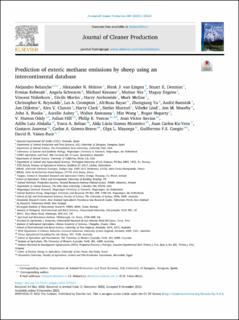| dc.contributor.author | Belanche, Alejandro | |
| dc.contributor.author | Hristov, Alexander N. | |
| dc.contributor.author | Van Lingen, Henk | |
| dc.contributor.author | Denman, Stuart J | |
| dc.contributor.author | Kebreab, Ermias | |
| dc.contributor.author | Schwarm, Angela Dagmar | |
| dc.contributor.author | Kreuzer, Michael | |
| dc.contributor.author | Niu, Mutian | |
| dc.contributor.author | Eugène, Maguy A. | |
| dc.contributor.author | Niderkorn, Vincent | |
| dc.contributor.author | Martin, Cécile | |
| dc.contributor.author | Archimede, Harry | |
| dc.contributor.author | McGee, Mark | |
| dc.contributor.author | Reynolds, Christopher K. | |
| dc.contributor.author | Crompton, Les A. | |
| dc.contributor.author | Bayat, Ali-Reza | |
| dc.contributor.author | Yu, Zhongtang | |
| dc.contributor.author | Bannink, André | |
| dc.contributor.author | Dijkstra, Jan | |
| dc.contributor.author | Chaves, Alex V. | |
| dc.contributor.author | Clark, Harry | |
| dc.contributor.author | Muetzel, Stefan | |
| dc.contributor.author | Lind, Vibeke | |
| dc.contributor.author | Moorby, Jon M. | |
| dc.contributor.author | Rooke, John | |
| dc.contributor.author | Aubry, Aurelie | |
| dc.contributor.author | Antezana, Walter | |
| dc.contributor.author | Wang, Mi | |
| dc.contributor.author | Hegarty, Roger | |
| dc.contributor.author | Hutton Oddy, V | |
| dc.contributor.author | Hill, Julian | |
| dc.contributor.author | Vercoe, Philip E | |
| dc.contributor.author | Savian, Jean Victor | |
| dc.contributor.author | Abdalla, Adibe Luiz | |
| dc.contributor.author | Soltan, Yosra A | |
| dc.contributor.author | Gomes Monteiro, Alda Lucia | |
| dc.contributor.author | Ku-Vera, Juan Carlos | |
| dc.contributor.author | Jaurena, Gustavo | |
| dc.contributor.author | Gomez-Bravo, Carlos | |
| dc.contributor.author | Mayorga, Olga | |
| dc.contributor.author | Congio, Guilhermo F.S. | |
| dc.contributor.author | Yáñez-Ruíz, David R. | |
| dc.date.accessioned | 2023-04-05T07:54:07Z | |
| dc.date.available | 2023-04-05T07:54:07Z | |
| dc.date.created | 2022-12-19T10:08:04Z | |
| dc.date.issued | 2022-12-15 | |
| dc.identifier.citation | Belanche, A., Hristov, A. N., van Lingen, H. J., Denman, S. E., Kebreab, E., Schwarm, A., Kreuzer, M., Niu, M., Eugène, M., Niderkorn, V., Martin, C., Archimède, H., McGee, M., Reynolds, C. K., Crompton, L. A., Bayat, A. R., Yu, Z., Bannink, A., Dijkstra, J., … Yáñez-Ruiz, D. R. (2023). Prediction of enteric methane emissions by sheep using an intercontinental database. Journal of Cleaner Production, 384, 135523. | en_US |
| dc.identifier.issn | 0959-6526 | |
| dc.identifier.uri | https://hdl.handle.net/11250/3062187 | |
| dc.description.abstract | Enteric methane (CH4) emissions from sheep contribute to global greenhouse gas emissions from livestock. However, as already available for dairy and beef cattle, empirical models are needed to predict CH4 emissions from sheep for accounting purposes. The objectives of this study were to: 1) collate an intercontinental database of enteric CH4 emissions from individual sheep; 2) identify the key variables for predicting enteric sheep CH4 absolute production (g/d per animal) and yield [g/kg dry matter intake (DMI)] and their respective relationships; and 3) develop and cross-validate global equations as well as the potential need for age-, diet-, or climatic region-specific equations. The refined intercontinental database included 2,135 individual animal data from 13 countries. Linear CH4 prediction models were developed by incrementally adding variables. A universal CH4 production equation using only DMI led to a root mean square prediction error (RMSPE, % of observed mean) of 25.4% and an RMSPE-standard deviation ratio (RSR) of 0.69. Universal equations that, in addition to DMI, also included body weight (DMI + BW), and organic matter digestibility (DMI + OMD + BW) improved the prediction performance further (RSR, 0.62 and 0.60), whereas diet composition variables had negligible effects. These universal equations had lower prediction error than the extant IPCC 2019 equations. Developing age-specific models for adult sheep (>1-year-old) including DMI alone (RSR = 0.66) or in combination with rumen propionate molar proportion (for research of more refined purposes) substantially improved prediction performance (RSR = 0.57) on a smaller dataset. On the contrary, for young sheep (<1-year-old), the universal models could be applied, instead of age-specific models, if DMI and BW were included. Universal models showed similar prediction performances to the diet- and region-specific models. However, optimal prediction equations led to different regression coefficients (i.e. intercepts and slopes) for universal, age-specific, diet-specific, and region-specific models with predictive implications. Equations for CH4 yield led to low prediction performances, with DMI being negatively and BW and OMD positively correlated with CH4 yield. In conclusion, predicting sheep CH4 production requires information on DMI and prediction accuracy will improve national and global inventories if separate equations for young and adult sheep are used with the additional variables BW, OMD and rumen propionate proportion. Appropriate universal equations can be used to predict CH4 production from sheep across different diets and climatic conditions. | en_US |
| dc.language.iso | eng | en_US |
| dc.publisher | Elsevier Ltd. | en_US |
| dc.rights | Navngivelse 4.0 Internasjonal | * |
| dc.rights.uri | http://creativecommons.org/licenses/by/4.0/deed.no | * |
| dc.title | Prediction of enteric methane emissions by sheep using an intercontinental database | en_US |
| dc.title.alternative | Prediction of enteric methane emissions by sheep using an intercontinental database | en_US |
| dc.type | Peer reviewed | en_US |
| dc.type | Journal article | en_US |
| dc.description.version | publishedVersion | en_US |
| dc.rights.holder | © 2022 The Authors | en_US |
| dc.source.volume | 384 | en_US |
| dc.source.journal | Journal of Cleaner Production | en_US |
| dc.identifier.doi | 10.1016/j.jclepro.2022.135523 | |
| dc.identifier.cristin | 2095018 | |
| dc.relation.project | EC/H2020/101000395 | en_US |
| dc.source.articlenumber | 135523 | en_US |
| cristin.ispublished | true | |
| cristin.fulltext | original | |
| cristin.qualitycode | 2 | |

